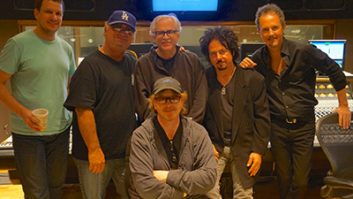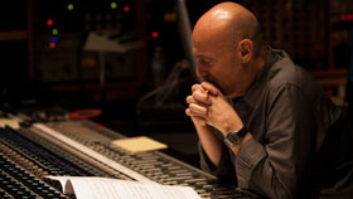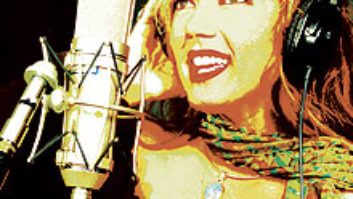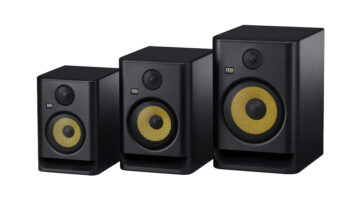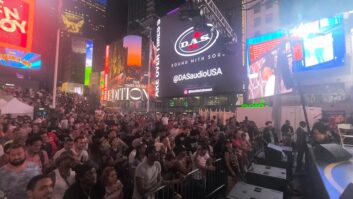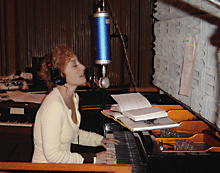
Tori Amos at work on American Doll Posse in her Martian Engineering studio
In 1908, Swiss psychiatrist Eugen Bleuler gave us the term schizophrenia. In 1973, The Who created Quadrophenia. And in 2007, Tori Amos gives us, well, let’s call it “quintuplephenia.” For her ninth studio album, American Doll Posse, released this past May, Amos has split herself into five different personalities: political Isabel, insecure Clyde, “warrior woman” Pip, passionate Santa and Tori, a caricature version of Amos herself. Most of these women are in their late 80s, and each of them sings several songs on the album, which holds a whopping 23, or 24 or 26 tracks, depending on the version, and, yes, it can get confusing.
As a marketing device, the five-way split-personality ploy has worked wonders: It has intrigued even passing fans, given journalists something to write about and has allowed Amos to run five additional blogs and MySpace pages. The pianist/singer has been popping up in the media in recent months due to her political views. However, when speaking to Amos in the flesh, it quickly becomes obvious that, while the five-character approach unquestionably aims to expand the reach of American Doll Posse, the artist isn’t simply looking for media coverage; she’s trying to be as effective as possible in tackling what she sees as one of the greatest threats to the future of the U.S. and of humanity: George W. Bush and his colleagues.
“I have an allergy to your policies,” Amos sings on the album’s opener, “Yo George,” and sitting in her basement writing room at Martian Engineering, her studio in Cornwall, England, she ardently elaborates. “The main message of the album is: The political is personal,” she explains, “as opposed to the feminist statement from years ago that the personal is political. There’s so much that’s not expressed in a country that should be the land of the free. At the same time, there’s so much concern, it’s beyond concern; the U.S. has chosen to put people in authority that are taking us down a very dark road.”

Amos has lived in the UK for more than a decade, but having been born and raised in the U.S., she still feels a deep connection to her native country. And so she has decided to tackle what she views as an authoritarian and war-mongering president, who she feels believes that the truth is something that can be made up. And so, when Amos laments “the madness of King George,” she isn’t just being hyperbolic.
SAVED BY A MARTIAN
More pertinent to Mix is the musical and production side of all this political brouhaha. Amos is sometimes viewed as a piano-playing waif who revels in singing gorgeous, string-soaked ballads. But her ballads almost always contain a steely, unsettling core, and over the years she has also recorded quite a lot of hard-hitting material, featuring angular prog-rock grooves and all manner of electronic experiments — distortion, sampling, loops, synthesizers and the like. American Doll Posse isn’t short of gorgeous ballads, but what’s new is the liberal use of heavily distorted guitars and the general feeling of a band rocking out together rather than just bass and drums backing Amos and her keyboards.
Amos was fully responsible for the change in direction — she not only wrote all of the songs, but she also produced the album. “I stepped into producing,” she says, “for Boys for Pele [1996, her third album] because I was fighting for my artistic life. Atlantic wanted another record like Under the Pink [1994, her second album]. But I knew that if I delivered that, it would be all over for me. You cannot repeat yourself exactly the same way. People move on.”
Maintaining control of her musical output has always been essential to Amos, particularly because of a long battle she fought with Atlantic, which culminated in the company releasing her in 2002, when the artist moved over to Sony/Epic. Another manifestation of her quest for autonomy is her recording studio in Cornwall, Martian Engineering, where she has recorded all of her music since From the Choirgirl Hotel [1998], the follow-up to Boys for Pele.
She set up the studio on the advice of Peter Gabriel. “Had I not listened to him,” she recalls, “I don’t think I would have survived the war with Atlantic Records. But we were here in Martian Engineering, and in control and in command of the music, and the record company only had access to the master tapes that I gave them. I’ve heard stories of artists standing outside and banging on doors, screaming, ‘Give me my f***ing masters!’”
Amos built Martian Engineering in 1997 with the help of Mark Hawley and Marcel van Limbeek, her live and studio sound engineers since Boys for Pele; the former is also her husband. The gear at Martian is state-of-the-art, with a Neve VR Legend VSP 7.1 68-channel desk with Flying Fader automation, complemented by a fully loaded Pro Tools HD3 Accel system, using three Apogee AD16X converters for inputs and three Apogee DA16X converters for outputs. Hawley and van Limbeek clearly mean business when it comes to hi-fi sound. This is also borne out by the impressive collection of microphones, preamps and outboard, featuring models from Neumann, AKG, Focusrite, GML, Lexicon, Tube-Tech and so on. All five rooms — four live spaces and a control room — were acoustically designed by van Limbeek, with diffusers creating uniform acoustics throughout.
“Studio technology has been much harder to come to terms with for me than performance technology,” Amos admits. “We’re pretty geared up in Martian, and I think I have made friends with what’s there now. I don’t regard studio equipment as the destroyer of the organic musician anymore. I had to sit back to be able to see the subtleties and endless possibilities of studio technology. I’ve lived with all the boxes and knobs. I understand what Pro Tools does. I believe in using all these things as instruments, and have learned how to use them musically instead of letting them homogenize my work. And so it’s a cop out not to embrace it. Now what’s happening for me is that I treat these elements as part of the arrangement.”
TRACKING THE ARTIST
The process of recording an album apparently begins with Amos and her preferred writing aids: books, a Bösendorfer grand piano, a compact cassette recorder and a boom box. “For this album, she spent much more time on her own, thrashing out the songs and the structures, than for other albums,” recalls Hawley. “In the past, she’d come to Marcel and me when the songs were half-written, and we’d record some really great piano/vocal demos, but this time they were almost finished by the time Matt [Chamberlain, drummer] and Jon [Evans, bassist] came in.
“They’re great players, and in the three weeks that they were here, they and Tori laid down two tracks a day,” Hawley continues. “Tori would play them the song in the morning, and Matt would do a loop rather than play to a click. He builds the loops himself in Ableton Live. I will put it into Pro Tools and they play to that. Sometimes a loop survives and actually makes it onto the track, like it did on ‘Digital Ghost.’
“They always track together, all three of them. Jon will sit here in the control room, Tori in one live room, and Matt in another. They may do eight or nine takes, and Jon or Matt may add a few fixes to improve their parts. But usually what you hear is what they’ve played. Tori is at her best when she plays piano and sings at the same time, and in a song like ‘Beauty of Speed,’ she played Bösendorfer and upright piano at the same time. Although we have a screen behind her vocal microphone to separate it from the piano, you can definitely hear the crosstalk between piano and vocal. So we can’t really edit Tori’s vocals like you can with most people. The only thing that we can do is splice different takes together.”
The guitars, of which there are many on American Doll Posse, are played by the mysterious Mac Aladdin. He also appeared on Amos’ previous two studio albums, but has never been seen on the live stage or spotted on albums by any other artist. It can be revealed here that the name is an alias — but avid Amos fans already worked that out a long time ago. In addition, the album features a string quartet, a tuba and a euphonium, all arranged by long-standing Amos collaborator John Philip Shenale. Guitars, strings and brass were overdubbed, also at Martian.

Amos’ piano is miked with two Neumann U87s.
Van Limbeek looks after recording Amos, giving the Hawley/Amos man-and-wife tandem a bit of space. Van Limbeek notes, “For the new record, Tori’s piano is recorded with two Neumann U87 mics, placed under the lid, in an M-S pattern, one set to omni or cardioid and the other to figure-8, going through a GML 8304 preamp. Before that, I’d use two U87 microphones with cardioid patterns, placed phase-coherent with a bit of space between them. In the past, I always used the Focusrite RED 1. You have to change your setup at times; you can’t have every record sound the same.
“Just like with The Beekeeper,” continues van Limbeek, “we began recording Tori’s vocals on the new album with the Blue Bottle, but one-third into the recording we obtained the Korby KAT-5, which is a fantastic microphone. You can change the capsules to get the characteristics of several classic microphones. It sounds amazing and the noise floor is so much better than with many of the older microphones. We used it for the remainder of the sessions, varying the microphone capsule and preamp per song, and sometimes inside of a song, but mostly we used the U47 capsule. She sometimes has very elaborate vocal arrangements, so it helps to have different vocal sounds inside of a song. A typical mix chain on the vocals may be Neve 1084 first, then LA-2A or 1176, depending on what sound we want, then GML EQ.”
“The electric guitars were all recorded with a dynamic microphone,” says Hawley. “Marcel had met Bob Heil, who is a legend in the P.A. system world, and he made these new Heil Sound PR40 microphones, and they are absolutely stunning. They have a much better high end than most conventional dynamic microphones, and at the same time they have all the good qualities of dynamic microphones, in that they don’t distort. We put the PR40 on the guitar cabinets and ran it through a Neve 1084 mic pre, and sometimes through a Chandler EMI copy preamp and then straight into Pro Tools.
“For the acoustic guitar, mandolin and ukulele, I used the B&K 4003 in omni mode, using the B&K mic pre straight into Pro Tools. I’ve always used cardioid mics and was never really happy with the sound I was getting. So for this album, I tried an omnidirectional mic, placed quite close, and I found that it works well because you don’t get that horrible proximity effect. But, of course, it does depend on the room being great.
“We always record Jon’s bass direct,” Hawley continues, “but we also miked some speakers up, using Neumann KM140 cardioids. He has his own compressor, and we didn’t add any. The distortion you hear on the bass on ‘Body and Soul’ comes from a distortion pedal that he uses. We had 13 microphones on Matt’s drums, including a pair of B&K 4003 mics behind his head and an [AKG] C-12 above the snare and one above the floor tom.”
Despite using Pro Tools and their love of digital in general, Hawley and van Limbeek still seem to prefer to work out of the box as much as possible. “We tend to use Pro Tools purely for editing and as a tape machine,” explains Hawley. “But we do everything else outside of Pro Tools, and for the mix we go through the Neve desk and use almost only outboard gear.

Amos’ engineers are her husband, Mark Hawley (left), and Marcel van Limbeek.
“We used a couple of plug-ins for American Doll Posse. We applied the Massenburg Design Works digital EQ fairly extensively. It’s brilliant — precise and smooth and extremely neutral; it doesn’t change the color of whatever you are treating. We also used all our outboard EQs. The Massenburg plug-in was mainly used to filter low end. Another plug-in that we used was Sound Toys, just for some crazy effects, and that’s it.”
As for the mixes, “They were fairly straightforward,” states Hawley, “just EQ and a little bit of Lexicon 480 or 960 plate reverb and sometimes something like a chorus to fatten up the vocals a little bit. The presence of the distorted electric guitars required a little bit of additional EQ because they’re in the same range as Tori’s vocals, and we still wanted her vocals to pop out and be well on top.”
Mixdown of American Doll Posse was to Martian Engineering’s SADiE Series 5 DSD format. Van Limbeek, Hawley and Amos’ regular mastering engineer, the legendary Jon Astley (The Who, Led Zeppelin, George Harrison), all sang the praises of the SADiE system. “Martian has an early, stereo-only Series 5,” explains Astley, “which was given to me by SADiE for try-out. For mastering we went from the SADiE via DCS converters to analog, then through a Manley Active Passive and a Prism MEA-2 stereo EQ, and then back through a DCS converter into my SADiE Series 5 at 24/96, after which I treated the sound with a Daniel Weiss EQ1-LP and DS1 compressor/limiter/de-esser, and then back through a DCS converter into my SADiE Series 5 DSD at 24/96, after which I treated the sound with the TC Electronic 6000 and the MD4 to add a dB or two. We went from 96 to 44.1 in the SADiE, which works really well. Finally, we did 24-bit to 16-bit dithering using the Daniel Weiss POW-R.”
After the mastering of American Doll Posse early this year, Martian Engineering for the first time opened its doors to outside customers. Now a residential commercial facility when Amos is not recording there, it boasts four bedrooms, a Jacuzzi, a dining room, a gym and splendid views of the surrounding Cornish countryside.
Amos is philosophical about the commercial potential of her new album, knowing that music and politics are often uneasy partners, especially in the U.S. And unlike an album like Neil Young’s controversial Living With War, which struck a chord with a few baby-boomers but not many others, American Doll Posse is aimed at a much different audience. “I’m after [Young’s audience’s] teenage daughters. This is about rousing 18-year-olds to wake up and make choices.”
